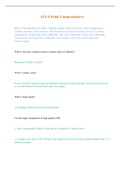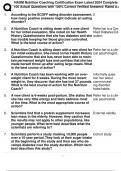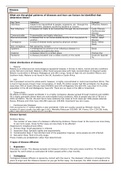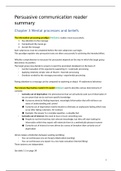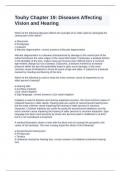College aantekeningen Resilience to violence
College 1
Short history of resilience to violence
Childhood trauma source of many other mental and physical health problems
Adverse childhood experiences: abuse, neglect, adults using alcohol drugs,…
Around half of all adults have experienced adverse childhood experiences
Study: 50% of adults experienced, often multiple problems occur, not only depression or anxiety, 30%
of all disorders caused by adverse childhood experiences.
Risk predicts risk
Snowballing effects → if u experience 1 u are more vulnerable to experience other problems. The
more ACE the worse the problems.
The consequences of failing to address adolescent mental health conditions extend to adulthood,
impairing both physical and mental health.
Covid pandemic triggers increase 25% of anxiety and depression
Japan earthquake disaster caused a lot of stress for nearly half respondents experiences physiological
stress
Mental health crises among children in Gaza
Ecological systems theory → physical environment, social and individual all spiral together, with a
disaster they all worsen each other, co-exist and co occur
Why do some children experience violence, trauma develop poorly whilst other don’t?
3 questions
1. Who stays well and recovers well?
2. How?
3. How can we promote and protect health and positive development?
,4 waves of resilience research
- Wave 1: what is resilience?
- Wave 2: how do resilience processes work?
- Wave 3: can resilience be promoted through interventions?
- Wave 4: how do dynamic processes systems (including brain and genetics) contribute to
resilience?
Wave 1 → what is resilience?
Focusses on individual factors. Started in 1970
Person focused model of resilience
- Single case studies (ex: why does Harry Potter do well?)
- Aggregate studies (Kuai)
- Recent: individual differences-
Classic model: compare vulnerable and resilient people
Expended classic model: patients and healthy
Classic model: the children of Kauai study
2/3 children low risk, 1/3 at high risk. They followed these children till age 10-18
Of high risk group: 2/3 were troubled, 1/3 resilient
Wave 2 → how do resilience processes work?
Focusses on processes (how questions). How does it work? 1990
Variable focused model of resilience: statistically test patterns among variables in groups of
individuals
Main effects model → friends can have an effect on the well-being which has an effect on CA
Mediation → friendships explains CA and wellbeing
Classic Moderation → association between CA and well-being gets stronger or weaker cause of
support from teachers
Risk activated moderation (airbag)
Bronfenbrenner’s ecological systems model
Micro: peers, family, friends
Meso: links between home and school, between peer and family
Exo: linkages between two or more settings, which effects individual indirectly
Chrono: time/period in which u grow up
Developmental systems theory: a person’s development is affected by the complex interactions
,Wave 3 → can resilience be promoted through interventions?
Interventions, testing theories, 2007
Exemple dictator in Romamia:
- Abortion illegal
- Menstrual police; woman have to have more than 5 kids
- Celibacy task: heavy task if less than 5 kids
- Lots of infants abandoned-> orphanages
Bucharest Early intervention
Kids that were placed in other homes/adopted
Looks at effects on the brain and behavioural development of young children
Wave 4 → how do dynamic processes systems (including brain and genetics) contribute to resilience?
Integrating genetics, neurobio
Hybrid models: growth models, network models
Resilience factors on multiple explanatory levels
The definition of resilience → the capacity to recover quickly from difficulties, toughness
Also the ability of a substance or object to spring back into shape.
Definitions in book
– Capacity (potential or manifested) of a dynamic system to adapt successfully to disturbances
that threaten system function, viability or development.
– Positive adaptation or development in the context of significant adversity exposure
‘The dynamic process of adaptation to stressful life circumstances’.
Resilience after CA is inferred ex post facto: Good mental health following an adverse life event or a
period of difficult life circumstances
, 2 criteria for resilience
Positive adaption or development in the context of significant adversity exposure
Positive adaptation:
- Competence or success in age-salient developmental tasks (ex: being able to walk)
- Developmental cascades
- Absence of mental health problems
Patterns of resilience
Are they always resilient?
Resilience trajectories
- Stress invulnerable or stress resistant → resistant to any type of stress, doesn’t go up nor
down- straight line
- Trauma and recovery (late bloomers) → does well but after trauma there is a dip, that
recovers back to normal
- Major shift or normalization → begins bad and goes back to normal after trauma
- Post-traumatic growth → after trauma they do better than before, they improved
Implications
Resilience is dynamic → With a person, Between people
Resilience process likely varies for different trajectories
Timing matters → if we label a person as being resilient, we would come to different conclusions
depending on the time that we label them
Prevalence of resilience
Most of the troubled 2/3 of the high risk groups of the study of
Kauai were late bloomers, would be better in there later years
30/40
Especially young people would recover more
With what type of research did the field start? Risk vulnerability,
focussed on who is vulnerable and who not
What are the key findings of Kuai study – 1/3 of children showed resilient at age 10-18
Fourth wave?- integration genes to geo-politics, systems approach
How did the def of resilience change over time? More dynamic and more focussed of these systems
Two requirements?- risk and positive adaption
How many children display resilience after child maltreatment?- depends on the definition of
adaption
College 1
Short history of resilience to violence
Childhood trauma source of many other mental and physical health problems
Adverse childhood experiences: abuse, neglect, adults using alcohol drugs,…
Around half of all adults have experienced adverse childhood experiences
Study: 50% of adults experienced, often multiple problems occur, not only depression or anxiety, 30%
of all disorders caused by adverse childhood experiences.
Risk predicts risk
Snowballing effects → if u experience 1 u are more vulnerable to experience other problems. The
more ACE the worse the problems.
The consequences of failing to address adolescent mental health conditions extend to adulthood,
impairing both physical and mental health.
Covid pandemic triggers increase 25% of anxiety and depression
Japan earthquake disaster caused a lot of stress for nearly half respondents experiences physiological
stress
Mental health crises among children in Gaza
Ecological systems theory → physical environment, social and individual all spiral together, with a
disaster they all worsen each other, co-exist and co occur
Why do some children experience violence, trauma develop poorly whilst other don’t?
3 questions
1. Who stays well and recovers well?
2. How?
3. How can we promote and protect health and positive development?
,4 waves of resilience research
- Wave 1: what is resilience?
- Wave 2: how do resilience processes work?
- Wave 3: can resilience be promoted through interventions?
- Wave 4: how do dynamic processes systems (including brain and genetics) contribute to
resilience?
Wave 1 → what is resilience?
Focusses on individual factors. Started in 1970
Person focused model of resilience
- Single case studies (ex: why does Harry Potter do well?)
- Aggregate studies (Kuai)
- Recent: individual differences-
Classic model: compare vulnerable and resilient people
Expended classic model: patients and healthy
Classic model: the children of Kauai study
2/3 children low risk, 1/3 at high risk. They followed these children till age 10-18
Of high risk group: 2/3 were troubled, 1/3 resilient
Wave 2 → how do resilience processes work?
Focusses on processes (how questions). How does it work? 1990
Variable focused model of resilience: statistically test patterns among variables in groups of
individuals
Main effects model → friends can have an effect on the well-being which has an effect on CA
Mediation → friendships explains CA and wellbeing
Classic Moderation → association between CA and well-being gets stronger or weaker cause of
support from teachers
Risk activated moderation (airbag)
Bronfenbrenner’s ecological systems model
Micro: peers, family, friends
Meso: links between home and school, between peer and family
Exo: linkages between two or more settings, which effects individual indirectly
Chrono: time/period in which u grow up
Developmental systems theory: a person’s development is affected by the complex interactions
,Wave 3 → can resilience be promoted through interventions?
Interventions, testing theories, 2007
Exemple dictator in Romamia:
- Abortion illegal
- Menstrual police; woman have to have more than 5 kids
- Celibacy task: heavy task if less than 5 kids
- Lots of infants abandoned-> orphanages
Bucharest Early intervention
Kids that were placed in other homes/adopted
Looks at effects on the brain and behavioural development of young children
Wave 4 → how do dynamic processes systems (including brain and genetics) contribute to resilience?
Integrating genetics, neurobio
Hybrid models: growth models, network models
Resilience factors on multiple explanatory levels
The definition of resilience → the capacity to recover quickly from difficulties, toughness
Also the ability of a substance or object to spring back into shape.
Definitions in book
– Capacity (potential or manifested) of a dynamic system to adapt successfully to disturbances
that threaten system function, viability or development.
– Positive adaptation or development in the context of significant adversity exposure
‘The dynamic process of adaptation to stressful life circumstances’.
Resilience after CA is inferred ex post facto: Good mental health following an adverse life event or a
period of difficult life circumstances
, 2 criteria for resilience
Positive adaption or development in the context of significant adversity exposure
Positive adaptation:
- Competence or success in age-salient developmental tasks (ex: being able to walk)
- Developmental cascades
- Absence of mental health problems
Patterns of resilience
Are they always resilient?
Resilience trajectories
- Stress invulnerable or stress resistant → resistant to any type of stress, doesn’t go up nor
down- straight line
- Trauma and recovery (late bloomers) → does well but after trauma there is a dip, that
recovers back to normal
- Major shift or normalization → begins bad and goes back to normal after trauma
- Post-traumatic growth → after trauma they do better than before, they improved
Implications
Resilience is dynamic → With a person, Between people
Resilience process likely varies for different trajectories
Timing matters → if we label a person as being resilient, we would come to different conclusions
depending on the time that we label them
Prevalence of resilience
Most of the troubled 2/3 of the high risk groups of the study of
Kauai were late bloomers, would be better in there later years
30/40
Especially young people would recover more
With what type of research did the field start? Risk vulnerability,
focussed on who is vulnerable and who not
What are the key findings of Kuai study – 1/3 of children showed resilient at age 10-18
Fourth wave?- integration genes to geo-politics, systems approach
How did the def of resilience change over time? More dynamic and more focussed of these systems
Two requirements?- risk and positive adaption
How many children display resilience after child maltreatment?- depends on the definition of
adaption


